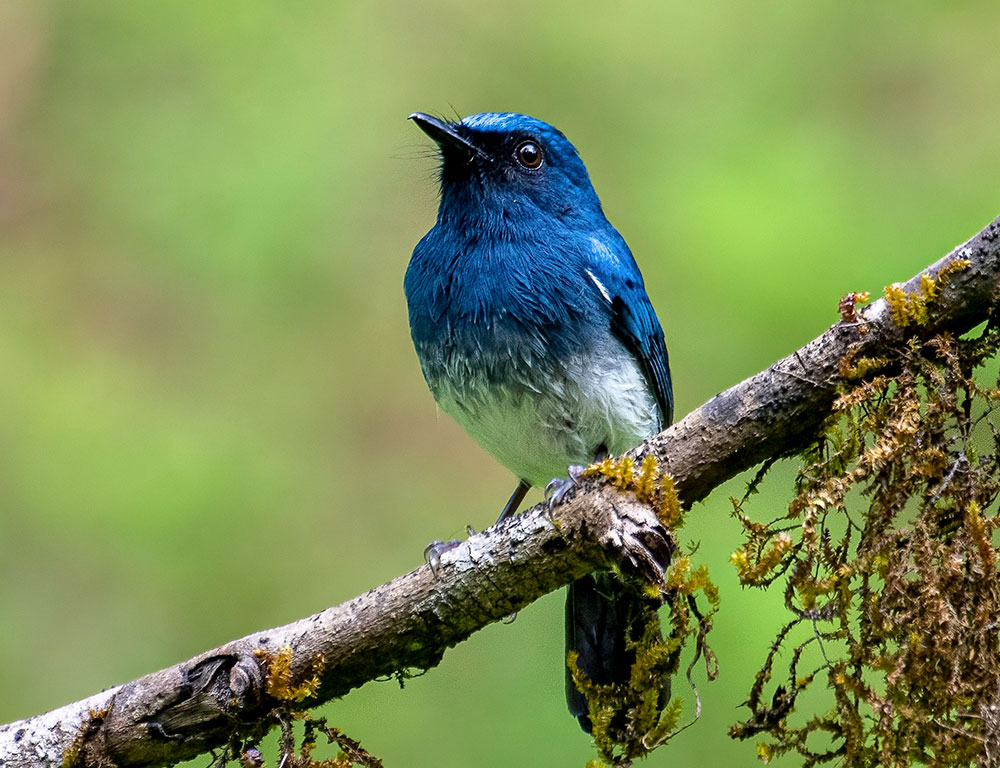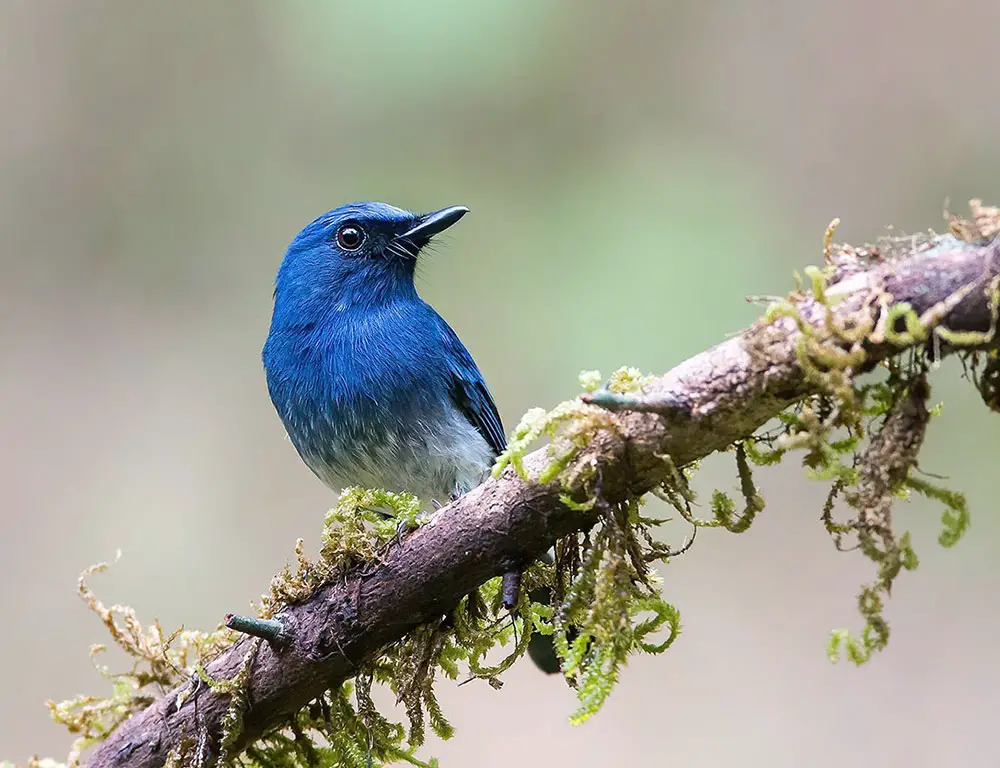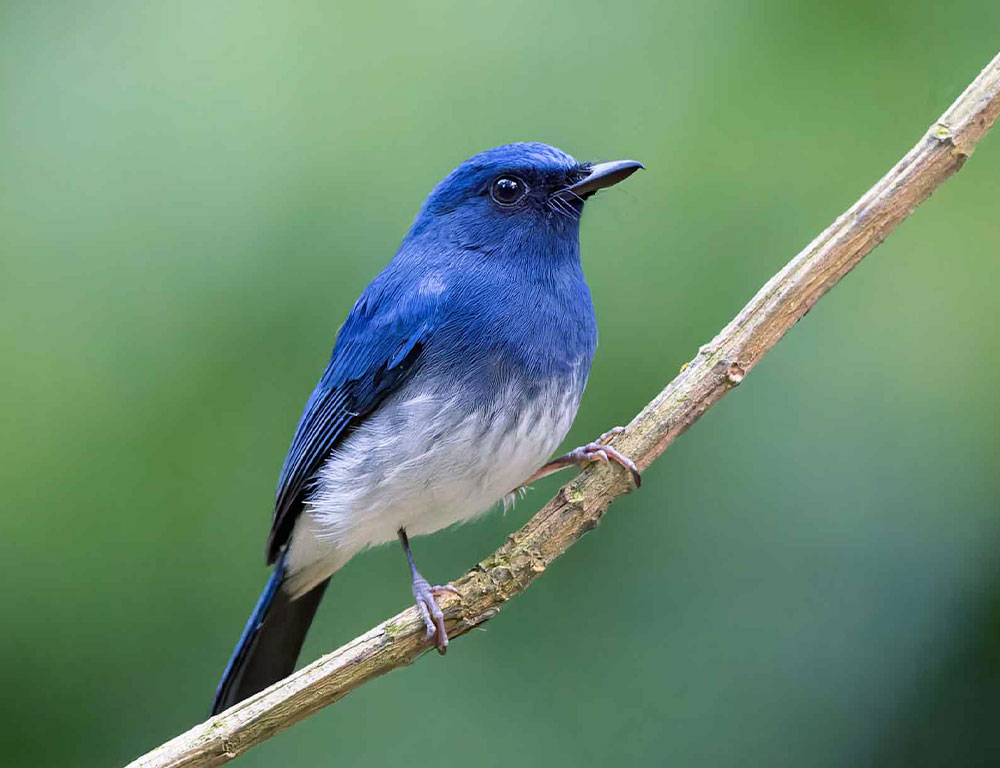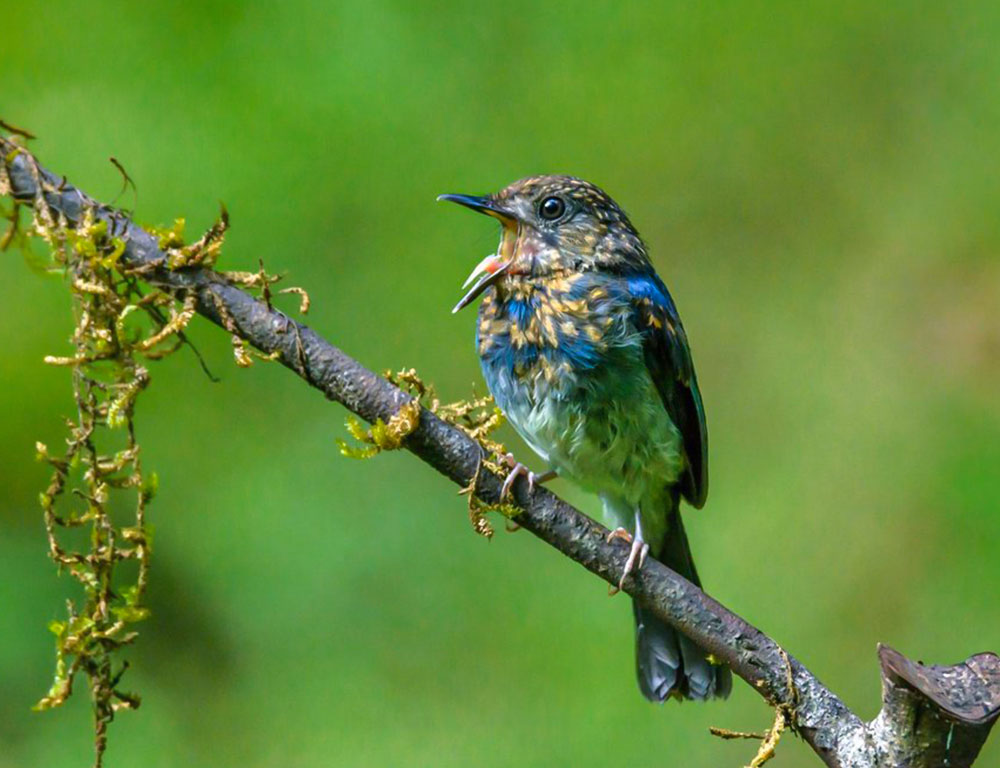I’ve always been fascinated by the stunning diversity of bird species. One that truly catches my eye is the White-bellied Blue Flycatcher.
Found mainly in the Western Ghats of India, this small passerine bird is a sight with its vivid blue feathers and contrasting white belly.
It’s interesting to note that male and female White-bellied blue Flycatchers showcase distinct colorations. While males flaunt a vibrant blue hue across their bodies, females sport a more subdued grey-blue coat.
This sexual dimorphism adds another layer of intrigue to these already captivating creatures.
While they may not be as famous as other colorful birds like parrots or peacocks, White-bellied blue Flycatchers hold their unique charm.
Their striking appearance and elusive nature make them exciting for any bird enthusiast or casual observer.
Habitat and Distribution of the White-Bellied Blue Flycatcher

The White-bellied Blue Flycatcher, a small passerine bird, has specific habitat preferences that play a crucial role in its survival and breeding behavior:
Primary Habitat
These birds primarily inhabit evergreen forests, particularly favoring areas with dense undergrowth and shrubs. They often nest low in the vegetation, utilizing the cover provided by the thick foliage.
Geographical Distribution
The White-bellied Blue Flycatcher is predominantly found in Southwestern India, particularly in the Western Ghats region extending from Goa to Kerala. Occasional sightings have also been reported in parts of Tamil Nadu.
Altitude Range
Their preferred altitude ranges from sea level up to 1200 meters. This suggests that they are adaptable to varying elevations within their habitat range.
Vegetation Preference
They show a distinct preference for areas with heavy rainfall, which supports lush vegetation growth. This preference for dense vegetation provides ample foraging opportunities and nesting sites.
Proximity to Water
The proximity to water bodies such as streams or rivers is another critical factor influencing their habitat choice. Access to water sources may increase insect activity, providing a steady food supply for the birds.
Physical Characteristics of the White-Bellied Blue Flycatcher

The White-bellied Blue Flycatcher exhibits several distinctive physical characteristics that contribute to its survival and thriving in its natural habitat:
Coloration
Males display a deep blue upper body contrasting sharply with bright white underparts, while females have a more subdued gray-blue plumage with pale yellowish-white underparts. This coloration likely aids in camouflage and mate attraction.
Size
These birds are relatively small, measuring around 13 centimeters (5 inches) in length on average. Their lightweight build, typically between 10 to 15 grams, allows them to move swiftly among trees and shrubs in search of food without expending excessive energy.
Beak
Despite its small size, the White-bellied Blue Flycatcher’s beak is short yet sturdy, suited for capturing insects mid-flight or plucking fruits off branches. This specialized beak morphology facilitates efficient feeding behavior.
Wings and Tail
Broad and rounded wings enable quick maneuvers in dense vegetation, their typical habitat.
Additionally, their long tail feathers are crucial in maintaining balance while perched and during flight, enhancing agility and control.
Diet and Feeding Habits of the White-Bellied Blue Flycatcher

The White-bellied Blue Flycatcher is primarily insectivorous, relying heavily on tiny insects as its primary food source.
Here are some key points about its diet and feeding habits:
Main Diet
The bird’s diet mainly consists of small insects, which it catches in mid-air or picks up from leaf surfaces. Everyday prey items include beetles and moths, with occasional consumption of spiders and rarely caterpillars.
Feeding Behavior
Known for its agile flight maneuvers, the White-bellied Blue Flycatcher darts suddenly from its perch to snatch unwary insects. This demonstrates its precision and speed in capturing prey.
Seasonal Variation
Feeding habits can vary seasonally, with increased feeding activity during monsoon months when insects are plentiful. Due to reduced insect availability, their feeding may be less frequent during drier periods.
Feeding Times
Like most birds, the White-bellied Blue Flycatcher is diurnal, meaning it is active and hunts during daylight hours. This aligns with its behavior of catching insects, which are also typically active during the day.
Individual Variations
While the general diet and feeding behavior remain consistent, individual birds may exhibit minor variations in diet preference and feeding behavior influenced by location, age, or season factors.
Conservation Status of the White-Bellied Blue Flycatcher

The conservation status of the White-bellied Blue Flycatcher is currently classified as “Near Threatened” by the International Union for Conservation of Nature (IUCN).
This designation indicates that the species is at risk of becoming endangered soon if significant conservation measures are not implemented to mitigate threats to its population and habitat.
The primary factors contributing to the precarious situation of the White-bellied Blue Flycatcher include:
Habitat Loss
Deforestation and urbanization lead to the destruction and fragmentation of the bird’s natural habitat, reducing available nesting and foraging areas.
Declining Population
Population estimates show a worrying decline in numbers over a relatively short period, indicating a rapid loss of individuals likely due to habitat destruction and other threats.
Climate Change
Rising temperatures and other climate-related changes can disrupt the bird’s breeding patterns and alter its habitat, further exacerbating population decline.
Conservation efforts to protect the White-bellied Blue Flycatcher and its habitat include:
Establishment of Protected Areas
Creating protected habitats where deforestation is restricted or prohibited can provide a crucial refuge for the species to breed and thrive.
Awareness and Education
Raising awareness about the plight of the species and the importance of its conservation through education programs can garner support for conservation initiatives and encourage sustainable practices.
Community Involvement
Engaging local communities in conservation efforts and promoting sustainable practices can help reduce human impacts on the birds’ habitat and facilitate their conservation.
National Parks and Reserves
Preserving natural areas such as national parks and reserves can provide essential sanctuaries for the White-bellied Blue Flycatcher and other threatened species to survive and recover.
Conclusion
I’ve spent considerable time diving deeply into the world of the White-bellied Blue Flycatcher. This bird has piqued my interest from day one with its striking blue plumage and contrasting white belly. It’s an intriguing creature that showcases nature’s remarkable diversity and beauty.
The White-bellied Blue Flycatcher is primarily found in the Western Ghats of India, favoring moist forest areas. Its habitat preference makes it a resident of some of the most biodiverse places on Earth.
Their diet consists mainly of insects, showing their crucial role in maintaining ecological balance. They help control insect population levels while serving as prey for larger predators. It’s another testament to how everything in nature interconnects.
Though not classified as endangered, these birds face challenges due to habitat loss from deforestation and agricultural expansion. We must continue our conservation efforts to ensure this species’ survival.
In summary:
- The White-bellied Blue Flycatcher is native to the Western Ghats
- Their primary diet includes insects
- Despite not being endangered, they face threats due to habitat destruction
First, I’d like to emphasize how every creature plays its part in our delicate ecosystem – even a small bird such as the White-bellied Blue Flycatcher holds significant importance.
By caring for our environment and creating awareness about different species living amongst us, we’ll do our part for biodiversity preservation.